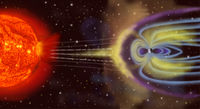
Photo from wikipedia
Abstract The Nigerian Total Electron Content (NIGTEC) is a regional neural network-based model developed by the Nigerian Centre for Atmospheric Research to predict the Total Electron Content (TEC) at any… Click to show full abstract
Abstract The Nigerian Total Electron Content (NIGTEC) is a regional neural network-based model developed by the Nigerian Centre for Atmospheric Research to predict the Total Electron Content (TEC) at any location over Nigeria. The addition of the disturbance storm time (Dst) index as one of NIGTEC's input layer neuron raises a question of its accuracy during geomagnetic storms. In this paper, the capability of NIGTEC in predicting the variability of TEC during geomagnetic storms has been assessed. TEC data predicted by NIGTEC is compared with those derived from Global Navigation Satellite System (GNSS) over Lagos (6.5oN, 3.4oE) and Toro (10.1oN, 9.12oE) during the intense storms in March 2012 and 2013. The model's predictive capability is evaluated in terms of Root Mean Square Error (RMSE). NIGTEC reproduced a fairly good storm time morphology in VTEC driven by the prompt penetration electric field and the increase in thermospheric O/N2. Nevertheless, it failed to predict increase in TEC after the intense sudden impulse of 60 nT on 8 March 2012. Also, it could not capture the changes in VTEC driven by the storm time equatorward neutral wind especially during 1800–2400 UT. Consequently, the RMSE were higher during this time window, and the highest RMSE value was obtained during the most intense storm in March 2012.
Journal Title: Geodesy and Geodynamics
Year Published: 2021
Link to full text (if available)
Share on Social Media: Sign Up to like & get
recommendations!